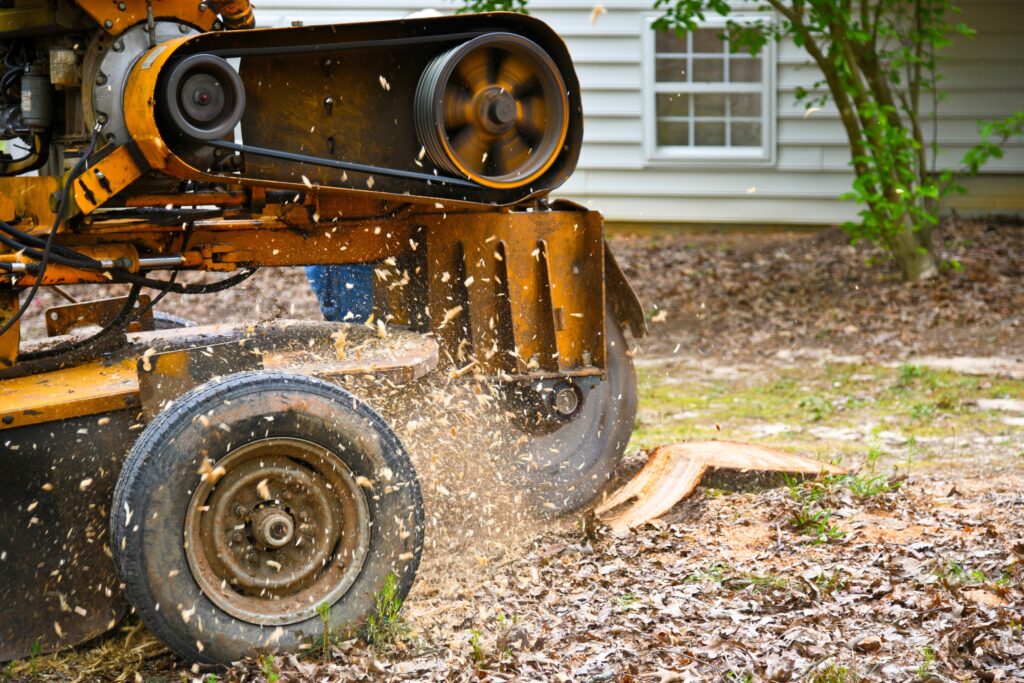Removing a tree stump can be a daunting task, but it’s an essential part of maintaining the health, safety, and aesthetics of your landscape. We understand that choosing the right method for stump removal can be confusing. That’s why in this blog, we’re going to break down the different methods of stump removal and help you determine which one is right for you.
1. Stump Grinding
Stump grinding is a widely used and highly effective method of removing tree stumps. It involves the use of a powerful machine equipped with a rotating cutting disk that grinds the stump down to well below the surface level. This method is particularly favored for its efficiency and minimal impact on the surrounding landscape.
Pros:
- Efficiency: Stump grinding is quick and effective.
- Minimal Damage: The process is localized and causes minimal disruption to the surrounding area.
- Cost-Effective: Stump grinding is generally less expensive than full stump removal.
Cons:
- Surface Only: Grinding removes the stump to below ground level but does not eliminate the root system.
- Debris: The process generates wood chips, which need to be cleaned up or repurposed.
Best For:
- Homeowners looking for a quick and cost-effective solution.
- Areas where preserving the landscape is important.
2. Chemical Stump Removal
Chemical stump removal involves the application of a chemical solution designed to accelerate the natural decomposition process of the stump. The process starts by drilling holes into the stump, then filling these holes with the chemical solution. Over time, the chemicals break down the wood fibers, making the stump easier to remove or allowing it to naturally decay.
Pros:
- Ease of Use: Relatively simple process that doesn’t require heavy machinery.
- Less Physical Labor: Minimal physical effort compared to manual removal.
Cons:
- Time-Consuming: Can take several weeks or months for the stump to decompose fully.
- Environmental Concerns: Chemicals can potentially harm surrounding plants and soil.
Best For:
- Homeowners who are not in a hurry to remove the stump.
- Situations where physical removal is impractical or too labor-intensive.
3. Manual Removal
Manual stump removal is a hands-on approach that involves physically digging out the stump and its root system using tools like shovels, axes, and saws. This method ensures that the entire stump, including its roots, is removed from the ground, providing a clean slate for new planting or landscaping.
Pros:
- Complete Removal: Eliminates the entire stump and root system.
- No Chemicals: Eco-friendly method without the use of chemicals.
Cons:
- Labor-Intensive: Requires significant physical effort and time.
- Potential for Injury: Higher risk of personal injury if not done properly.
Best For:
- Small stumps or those with shallow root systems.
- Homeowners who prefer a chemical-free approach.
Which Method is Right for You?
Choosing the right method for stump removal depends on several factors, including the size of the stump, your budget, time constraints, and environmental considerations. For quick and efficient removal, stump grinding is often the best choice. For those who want to avoid chemicals and ensure complete removal, manual methods are most effective, though labor-intensive.
At Clean Cut Tree and Landscaping, we’re here to help you make the best decision for your property or assist in your stump removal project. If you need expert advice or professional stump removal services, don’t hesitate to contact us. Your landscape’s health and beauty are our top priority.

